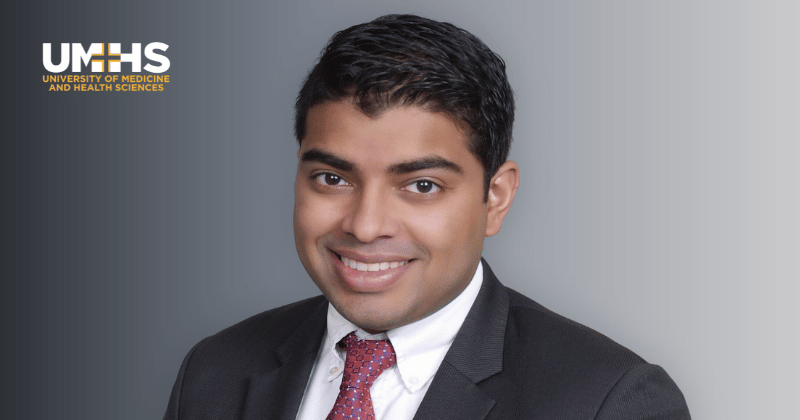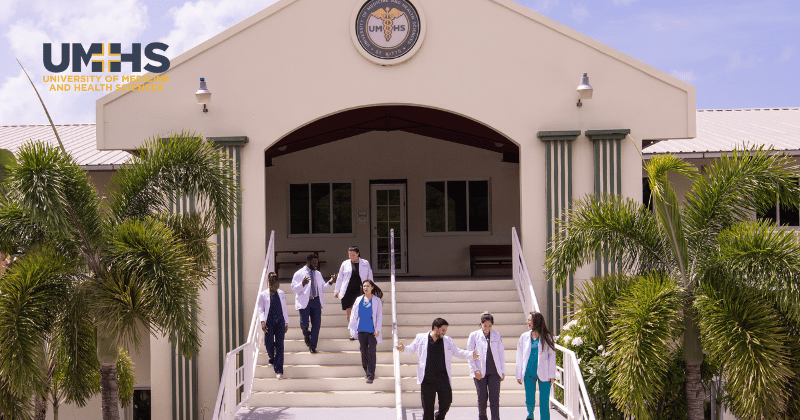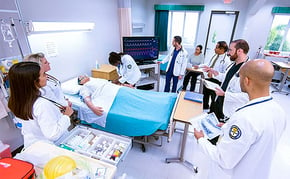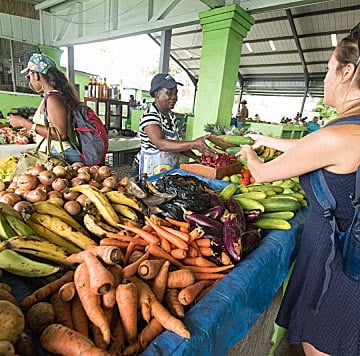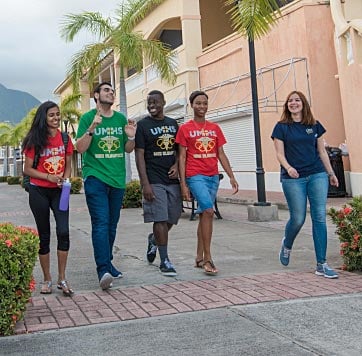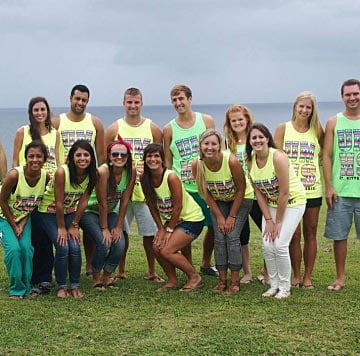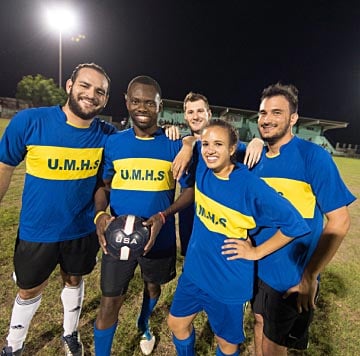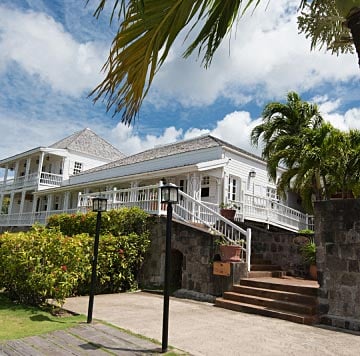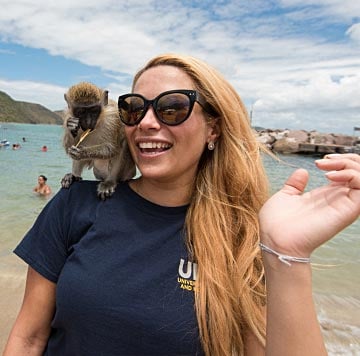Despite major advances in medical technology, access to essential care remains deeply inequitable, particularly in developing nations, where even basic health services are often out of reach. According to the World Health Organization, more than half of the global population still lacks access to critical healthcare. “Our world is an unequal one. Where we are born, grow, live, work, and age significantly influences our health and well-being,” said WHO Director-General Dr. Tedros Adhanom Ghebreyesus. “But change for the better is possible.”
With a mission to help drive that change, 23 dedicated UMHS students from Med4You traveled to the San Mateo Community in Antigua, Guatemala, to provide much-needed care. In a country where nearly 60% of the population lives below the poverty line and healthcare access, especially in rural and Indigenous communities, is limited, the team’s presence was deeply impactful.
Guided by faculty mentor Dr. Jagadeesh Nagappa, and in partnership with the UMHS Global Health Institute and Vida Volunteers, the team provided hands-on medical care and gained firsthand insight into the realities and rewards of global health service.
We spoke with Med4You President Natalia Sandin and trip participants Laela Piam and Yajie Jiang about their experiences: the challenges they faced, the impact they witnessed, and the lessons they’ll carry forward.
How did you get involved in Med4You?
Natalia Sandin:
When I arrived on the island, I started in the Accelerated Review Program (ARP). Although ARP students couldn’t participate fully in all club activities, I was eager to help, especially with health fairs and working with kids. I began volunteering early and gradually worked my way up in the club. I’ve loved it ever since. Med4You’s mission really resonates with me. St. Kitts has given me the opportunity to study medicine and follow my dreams, so I want to give back to the community here and abroad, like in Guatemala.
Yajie Jiang:
Med4You is one of the largest clubs at our school, so I learned about it during club days when members talked about volunteer opportunities both locally and internationally. I didn’t want my medical education to be just about studying; I wanted to practice as well. Med4You was the perfect fit. Each semester, we organize two student-led volunteer events where we practice skills like taking vitals while serving the community.
Describe your trip to Guatemala: How was it set up? What services did you provide?
Natalia Sandin:
I actually coordinated the trip, working closely with Vida Volunteers and contacts in Guatemala. I wasn’t just preparing myself. I made sure every student was ready, creating checklists and sharing essential info to help them prepare. It was a lot of work behind the scenes, but it ensured everything ran smoothly once we arrived.
Yajie Jiang:
We had two fantastic coordinators, Amy and Arianna, who guided us throughout. After settling in on the first day, we spent the second day in training sessions led by the coordinators and local doctors to familiarize us with common conditions we’d see. Starting the third day, we worked full days at clinics set up in community centers, usually from early morning until late afternoon. The local people were incredibly welcoming. Honestly, I didn’t know what to expect at first, but the whole experience was amazing and meaningful.
Laela Piam:
During our time there, we saw patients with a wide range of complaints, from headaches and joint pain to chronic conditions like diabetes. We took vital signs, tested blood glucose, and performed basic urine dipstick tests. Then, we presented each case to supervising doctors who confirmed diagnoses and prescribed treatment. It was a great opportunity to apply what we’ve learned while helping those in need.
What was the goal of the trip?
Natalia Sandin:
The goal was to offer a helping hand. Yes, we practiced our clinical skills and applied our knowledge, but Med4You is really about more than that; it’s about human connection and compassion. We saw cases that touched our hearts, and many patients told us that the care we provided felt better than what they usually received from their healthcare system. That meant the world to us. Med4You offers students the chance to grow not just as clinicians but as compassionate caregivers.
 UMHS students treating patients in Guatemala during their Med4You trip.
UMHS students treating patients in Guatemala during their Med4You trip.
How many patients did you treat?
Yajie Jiang:
We treated around 240 patients over three days. The first day was lighter with about 70-something patients, and by the last day, we saw 84 or 85. It was incredible to help so many people.
What types of patients did you treat?
Natalia Sandin:
Many patients suffered from respiratory issues like asthma and COPD, often due to smoke from cooking over open wood fires—a common practice there. We also treated diabetes, obesity, allergies, hypertension, and other chronic conditions. Most patients were women and children, as many men were working during clinic hours. I can count on one hand the number of men we saw.
Yajie Jiang:
We took full medical histories, recorded vital signs, and assessed symptoms. We worked in small groups to discuss possible diagnoses before presenting them to the local supervising doctors, who offered feedback and explained treatment choices. Many patients had upper respiratory infections, bacterial or viral, some with pneumonia. The volcanic dust caused many allergy symptoms. Other common issues included muscular pain from physical labor, gastrointestinal problems, and urinary tract or kidney infections. We also learned to differentiate infections and prescribe appropriate medications based on what was affordable and available: sometimes, the ideal treatments weren’t an option due to cost. It was humbling and eye-opening.
What did you learn?
Laela Piam:
I learned that patients rarely present with just one isolated symptom or disease. Diagnosing requires grouping symptoms and thinking beyond textbook cases. It taught me that real clinical practice isn’t always neat or straightforward.
Yajie Jiang:
This trip bridged the gap between classroom learning and hands-on experience. I still remember feeling nervous during my first patient encounter. Using a checklist helped, but I struggled at first. After a few patients, my confidence grew. Coming from a background as a mechanical engineer, this experience proved to me that I can succeed in medicine. It made me feel like I belong here.
What was the most memorable experience?
Laela Piam:
One patient came in with one complaint, but we discovered deeper issues. After reporting to the doctor, he gently raised the topic, but the patient was initially quiet. Suddenly, the patient asked to speak privately with us students. That trust and comfort made it a deeply memorable moment for me.
Natalia Sandin:
A man came in with severe headaches; he had been diagnosed with hypertension but wasn’t taking medication due to a lack of access. His blood pressure was dangerously high—260 over 130. I panicked and called our supervising doctor. He shared how tired he felt, had to reduce work, and couldn’t spend time with his family. We prescribed medication on-site and discussed lifestyle changes he could realistically make, like walking with his family in the evenings. That patient stayed with me. I still wonder if he’s managing his condition.
 UMHS students posing for a picture in Guatemala during their Med4You trip.
UMHS students posing for a picture in Guatemala during their Med4You trip.
Why are medical missions like the Med4You trip important for medical students?
Natalia Sandin:
This trip boosted my confidence. Many students fear their first clinical encounters, but I learned I can take histories, diagnose, and build trust. It prepared me for future clinical rotations and broadened my perspective on healthcare delivery across different countries. I’m committed to continuing this kind of service as I grow professionally.
Laela Piam:
Medical missions are vital because they allow us to apply all aspects of medicine—history taking, investigations, differential diagnosis, and treatment—in real-world settings. They also highlight how privileged we are. For instance, I used to wonder why we were taught to take manual blood pressure when automatic devices are common in hospitals. But in rural Guatemala, basic equipment is scarce, so knowing manual skills is crucial. The trip gave me a new appreciation for our training and resources.
Yajie Jiang:
Medical missions expose us to healthcare in underserved communities and the real suffering caused by poverty and lack of access. The kindness and compassion shown by local doctors in Guatemala inspired me and showed me the kind of physician I want to be. Medicine is about helping people, and without true compassion, you can’t fully express that passion. This trip connected me deeply to that purpose, and I believe every medical student can benefit from this experience.
How has the experience changed your outlook on medicine and healthcare delivery?
Laela Piam:
I gained a greater appreciation for a multidisciplinary approach to healthcare. Health centers should include diverse professionals—dietitians, counselors, and more—to address all aspects of a patient’s health. For example, someone diagnosed with diabetes should have easy access to nutritional counseling and psychological support to improve adherence to treatment. I also learned how culture shapes health; many people live close to nature but develop lung issues from cooking indoors with firewood. Understanding these cultural influences is key to effective care.
What advice would you give to future students considering one of these trips?
Natalia Sandin:
I encourage students to start by volunteering at the health fairs we hold here in St. Kitts. They help build essential clinical skills like taking blood pressure and pulse—skills you absolutely need on a trip like this. Some students want to go abroad but haven’t had hands-on practice, which makes a big difference.
In St. Kitts, patients understand we’re students and are open to us learning. But abroad, like in Guatemala or Costa Rica, patients expect more from us. That’s why we recommend students be in EBS3 or higher, so they have enough knowledge and experience to contribute meaningfully.
And honestly? Just go for it. If you feel the pull to participate, don’t let fear or finances hold you back. Do what you can to make it happen. These trips help you grow not only clinically but also in confidence and clarity about why you chose medicine. Getting involved with Med4You is one of the best ways to prepare.
____________________________________________________________________________
For these UMHS students, the Med4You trip to Guatemala was more than a clinical mission: it was a journey of growth, compassion, and a deepening commitment to serve. The lessons they gained will stay with them, shaping their paths as future physicians and global citizens.
Megan is a Public Relations & Communications Consultant for UMHS. When she's not working with UMHS faculty, students and alumni to promote their expertise through media coverage and special events, she enjoys spending time outdoors in her hometown of San Diego.


